
Types of Hospital Beds - The Ultimate Home Hospital Bed Buying Guide
Choosing the right home hospital bed is more than just a practical decision—it's a step toward ensuring comfort, safety, and dignity for those requiring in-home care. These specialized beds are designed to meet a variety of needs, offering features that can make caregiving easier while improving the overall quality of life for patients. Understanding what to look for can make all the difference in creating a supportive and secure environment.
Lets get right into it. In this guide, I’ll break down the essential elements to consider, helping you make an informed choice that benefits both patients and caregivers alike.
What are the Different Types of Hospital Beds?
Hospital beds are available in various types, each catering to specific needs and care requirements. These beds provide essential features like adjustability, mobility, and enhanced safety, making them vital for both patients and caregivers. Below is an overview of the main types:
- Manual Hospital Beds
Manual beds use hand cranks to adjust height, head, and foot sections. A caregiver must operate the cranks, making them dependent on physical effort. These beds are cost-effective but less convenient for frequent adjustments. Typically $500 to $800 price range.
- Semi-Electric Hospital Beds
Semi-electric models offer motorized adjustments for the head and foot sections while the height is manually adjusted. They balance ease of use and affordability, making them suitable for patients who need moderate adjustability.
- Fully Electric Hospital Beds
Fully electric beds allow total motorized control over height, head, and foot adjustments. They're highly convenient for patients with limited mobility and reduce caregivers' physical strain. These beds are common in home and facility care settings, and ideal if the patient spends more than 16 hours a day in bed.
- Bariatric Hospital Beds
Bariatric beds provide enhanced durability and a wider surface area to accommodate patients weighing more than standard capacities. Features include reinforced frames, electric adjustments, and wider side rails for safety.
- Homecare Style Beds (Luxury Home Hospital Beds)
Homecare beds combine the functionality of hospital beds with a more homely appearance. They're designed for in-home use, supporting long-term care with features like height adjustability and customizable aesthetics.
- Long-Term Adjustable Care Beds
These beds are tailored for prolonged use in homes or care facilities and our selected offering can be adjust via the width and length. They often include features such as adjustable side rails and advanced positioning options to improve safety and comfort over long periods. They can be found in semi electric, electric, and bariatric options.
Choosing the right type depends on the patient's specific medical needs, the caregiver's physical capacity, and the environment where the bed will be placed.
Let us start with:
Semi-electric hospital beds
Semi-electric hospital beds combine manual and electric controls, offering a balance between affordability and convenience. They're designed for patients requiring moderate assistance with bed positioning.
Semi Electric Hospital Bed
What Is a Semi-Electric Hospital Bed?
A semi-electric hospital bed has electric motors for head and foot adjustments, while height modifications are handled manually with a hand crank. These beds provide partial independence for patients and relieve some of the caregiver's workload.
Features and Benefits
Semi-electric beds are a fusion of functionality and cost-effectiveness. Their electric capabilities allow patients to adjust the head and foot elevations easily, while the manual height control ensures sturdiness and cost-saving.
Pros of Semi-Electric Hospital Beds
- Affordability: Costs range between $730 and $1,200, making them cheaper than fully electric beds.
- Simplicity: Electric head and foot adjustments reduce physical strain on caregivers.
- Reliability: Manual height adjustments ensure basic functionality even during power outages.
Cons of Semi-Electric Hospital Beds
- Manual Effort: Caregivers must use physical effort to adjust the bed's height.
- Limited Features: Semi-electric beds lack advanced options like Trendelenburg positioning.
- Dependency on Power: Electric adjustments require a stable power source.
Fully electric hospital beds
Fully electric hospital beds are the most advanced option for in-home care and for good reason. They provide complete adjustability using an electric motor, offering convenience for both patients and caregivers.
What Is A Full-Electric Hospital Bed?
A full-electric hospital bed allows users to adjust its height, head, and foot sections entirely via a remote or control panel. These beds eliminate physical strain during adjustments, promoting patient independence for those requiring frequent positioning changes. You can fully electric beds in the price range of $800 all the way to the $12,000 price level.
Features and Benefits of a Full Electric Medical Bed
Fully electric hospital beds prioritize ease of use and functionality. Their electric motors enable quick and precise adjustments, helpful for patients with limited mobility. Many models support advanced positioning options, such as Trendelenburg and Reverse Trendelenburg, aiding circulation and comfort.
Pros of Fully Electric Hospital Beds
- Complete Accessibility: Patients can adjust bed positions independently without caregiver assistance.
- Advanced Adjustments: Trendelenburg and Reverse Trendelenburg positions improve blood flow and comfort.
- Caregiver Support: Eliminates physical effort during adjustments, reducing caregiver strain.
Cons of Fully Electric Hospital Beds
- Higher Cost: Prices range from $800 to $12,000, making them the most expensive option.
- Power Dependency: Requires a reliable power source for uninterrupted functionality.
Bariatric hospital beds
Bariatric hospital beds are specially designed to accommodate individuals with larger body sizes and higher weight capacities. These beds enhance comfort and safety while addressing the unique needs of bariatric patients through specialized features.
What Is a Bariatric Hospital Bed?
A bariatric hospital bed supports greater weight and size capacities than standard beds. While some models can handle up to 1,000 pounds, others are built for weights between 350 and 750 pounds. These beds offer extra width, durable construction, and height adjustability, ensuring both patient care and caregiver convenience. Commonly equipped with safety rails and advanced controls, bariatric beds cater to individuals requiring robust, long-term support solutions.
Features and Benefits
Bariatric beds come with features designed to meet high-performance needs and ensure patient safety.
- Weight capacity: Handles significantly higher weights, accommodating patients traditional hospital beds can't support.
- Width and size: Provides extra space for patient comfort, improving the overall user experience.
- Height adjustability: Reduces strain for caregivers by offering easier access to patients.
- Safety rails: Enhances patient safety by minimizing fall risks during repositioning or transferring. Safety rails are not exclusive to heavy duty bariatric beds.
- Electric controls: Allows individuals to adjust bed positioning independently, promoting autonomy.
- Accessories: Optional features include bariatric mattresses, overbed tables, and additional safety rails.
These beds benefit both patients and caregivers by improving care delivery, reducing risks, and enhancing comfort.
Pros of Bariatric Hospital Beds
- Durable build: Steel frames and heavy-duty materials ensure reliability even with continuous use.
- Improved patient safety: Safety rails and optional exit alarms minimize injuries.
- Comfort: Extra-wide surface accommodates larger individuals, preventing discomfort or pressure sores.
- Adjustability: Electric controls make repositioning user-friendly and strain-free.
- Versatility: Usable in hospitals or at home for those requiring long-term bariatric-specific care.
- Optionality: You can find Bariatric Fully Electric and Bariatric Semi Electric as well as Manual options.
Cons of Heavy Duty Bariatric Beds
- Cost: Prices range from $1,500 to $6,000 or more, which may be unaffordable without insurance or Medicare coverage. Medicare might cover basic manual options, but nothing fancier.
- Cumbersome: The heavy structure makes these beds difficult to move or transport, making the white glove delivery essential.
- Accessory purchases: Some models do not include essential components like bariatric mattresses or side rails, increasing total costs. At MedShop we have special offer bundles for a bariatric bed with mattress.
- Power dependency: Fully electric models require a steady power supply, posing challenges during outages. It is generally recommended to purchase a backup batter option, and the price varies per manufacturer.
Despite drawbacks, bariatric hospital beds deliver a specialized solution suited for patients needing robust, long-term care support for heavy set individuals that deserve the level of comfort found in other hospital beds.
Adjustable Long Term Hospital Beds
Adjustable beds (Width + Height adjustability) offer significant flexibility by allowing modifications to positions for enhanced comfort, safety, and convenience. These beds cater to various medical and personal needs, making them a practical choice for home care settings.
Features and Benefits
Adjustable beds typically include electric height adjustment and positioning options for the head and foot sections. Some models also incorporate ergonomic features to optimize both lying and seated positions. This adjustability can reduce caregiver strain and support patients with limited mobility or specific medical conditions. For users at risk of falls, low bed models lower closer to the floor to minimize injury potential, while options like elevating sections improve posture and circulation.
Pros
- Customizable positioning: Enables personalized support, elevating or reclining specific sections for comfort.
- Minimized caregiver strain: Reduces physical effort during patient handling.
- Fall prevention: Low bed models enhance safety by reducing the distance to the floor.
- Enhanced independence: Electric adjustments allow users to reposition themselves easily.
Cons of Adjustable Width + Adjustable Height Hospital Beds
- High cost: Fully adjustable electric beds can cost between $1,000 and $8,000.
- Power-dependency: Models relying entirely on electricity can become non-functional during power outages.
- Maintenance complexities: Advanced features may require regular upkeep.
Hi Low Hospital Beds
A hi lo hospital bed for risk fall prevention is a great option for patients that require extra care. You can find extra low beds in standard and bariatric, bariatric electric, semi electric, and fully electric options. It offers the same features as a fully electric medical bed but with a bed deck positioned just 7 inches from the floor, with some going as low as 3" off the floor.. With the addition of a 6 to 8 inch mattress, the fall height is reduced.
Pros of Hi-Low Hospital Beds:
- Adjustable Height: Can be lowered to a very low position
- Safety Enhanced: It reduces the fall of patients who have problems in mobile situations
- Comfort Improved: Multiple positioning for comfort and pressure relief for the patient
- Versatile: Appropriate for home care and facility settings.
Cons of Hi Low Hospital Bed:
- Higher Cost: Some can be a bit more expensive as compared to a normal hospital bed because of the advanced features.
- Maximum Height: The max height might not be as high as others, although this is not always the case.
Frequently Asked Questions
What factors should I consider when choosing a hospital bed for home use?
When selecting a hospital bed for home use, consider the patient’s medical needs, bed adjustability, safety features like rails, weight capacity, comfort, and the caregiver’s physical capacity. Other factors include the bed’s type (manual, semi-electric, or fully electric), ease of use, and your budget.
What are the benefits of a fully electric hospital bed?
Fully electric hospital beds offer complete adjustability of height, head, and foot sections via remote or control panel. They reduce caregiver strain, enhance patient comfort, and promote independence. These beds also provide advanced positioning options, making them ideal for optimal care and convenience.
Are hospital beds covered by insurance or Medicare?
Yes, hospital beds may be covered by Medicare or private insurance if prescribed by a doctor. Coverage often requires documentation of medical necessity, outlining why a hospital bed is essential for the patient’s care. Most of the ti
What is the difference between a manual and semi-electric hospital bed?
Manual beds require physical effort to adjust all positions, making them more affordable but harder to use. Semi-electric beds allow electric adjustment of the head and foot sections while requiring manual height adjustments, offering a balance between functionality and cost.
Who benefits most from bariatric hospital beds?
Bariatric beds are specifically designed for individuals with larger body sizes or higher weight capacities. They offer enhanced comfort, safety, and durability, making them ideal for patients requiring extra width and stronger bed frames.
Can adjustable beds be used as hospital beds?
Yes, adjustable beds can serve as hospital beds for in-home care. They allow customizable positioning of the head and foot sections, enhancing comfort and addressing certain medical needs. However, they may lack some hospital-grade features like safety rails or weight capacities.
Do hospital beds require regular maintenance?
Hospital beds, especially electric models, benefit from regular maintenance. Checking for proper function of motors, controls, and safety features like rails is essential to ensure patient safety and prevent mechanical issues.
Are hospital beds portable or easy to move?
Most hospital beds are designed with wheels for mobility, but they can still be heavy and bulky. Fully electric and bariatric models tend to be more challenging to move due to their size and weight.
What are the cost ranges for hospital beds?
Hospital beds range in cost from $500 for manual beds to $8,000 or more for advanced fully electric or bariatric models. The price depends on features, adjustability, and the bed type.
Are hospital beds difficult to assemble?
Hospital beds typically come with assembly instructions and require basic tools. Fully electric and bariatric models may take more effort to assemble due to their complex features and size. We offer a flat white glove delivery and set up in your room of choice for $295. Often times it cost more than this, and we pay it out of pocket.






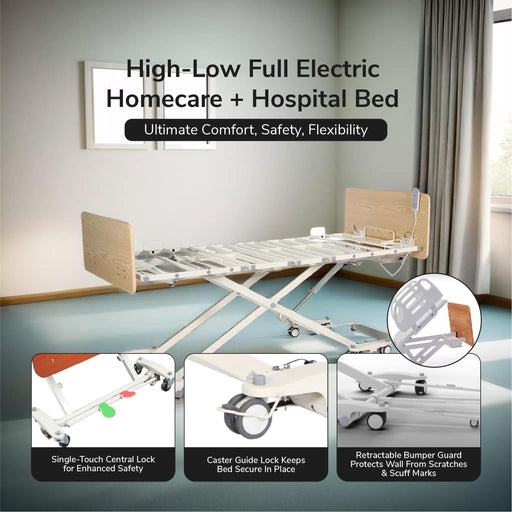
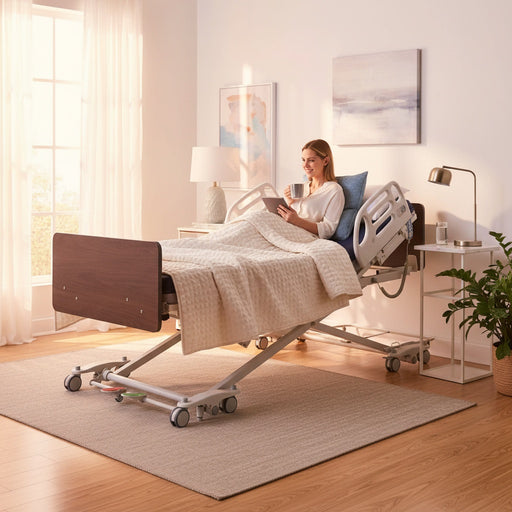
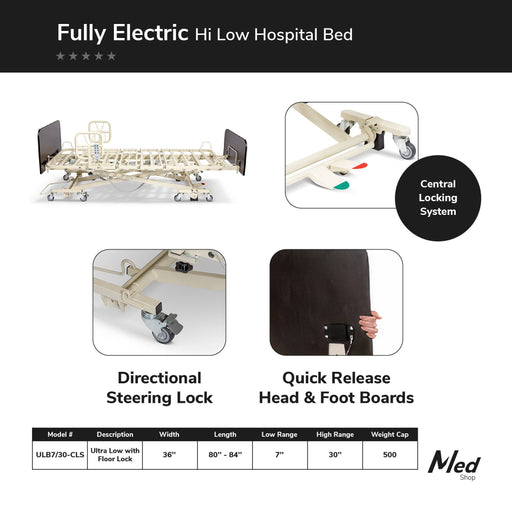
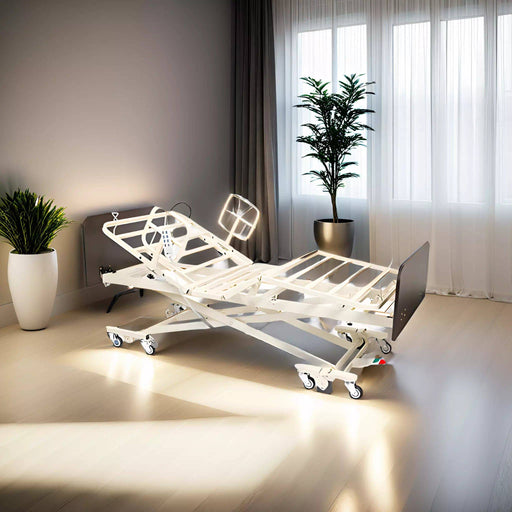


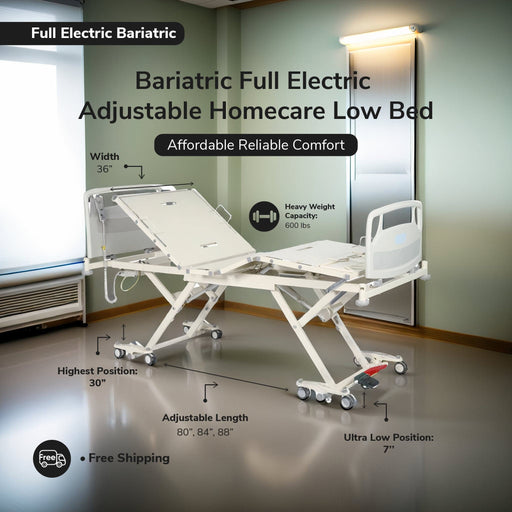
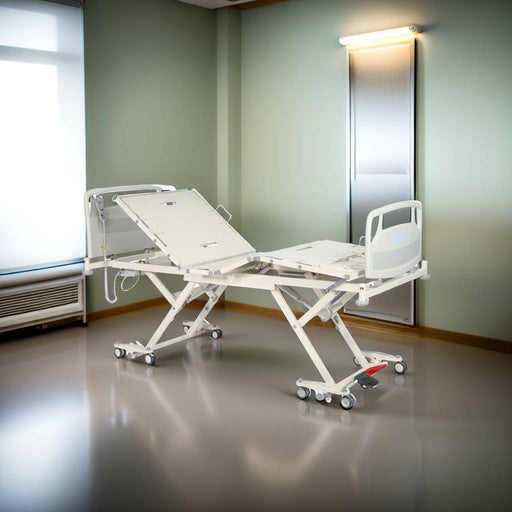
Leave a comment